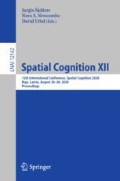Abstract
The paper presents and illustrates the strong spatial cognition paradigm in the example of catching a flying ball by means of an angular control strategy. The strategy makes constructive use of structural geometric properties of 2- and 3-dimensional space in a way that is similar to strategies used by athletes and animals to catch flying objects. We contrast this strategy to predictive approaches employed in robotics: In these approaches, geometric properties are formally reconstructed from analytical domain knowledge which athletes and dogs do not require for catching balls or frisbees. A familiar spatial constellation of a shadow projection helps to understand the geometric principles which enable a constant angular control strategy. We illustrate the structural geometry of the approach by an interactive implementation in a game engine environment that permits observing and tracing the spatial dynamics. We show how the environment can “compute" for us and illustrate how this structural geometry can be used to solve spatial cognitive tasks.
Access this chapter
Tax calculation will be finalised at checkout
Purchases are for personal use only
Notes
- 1.
Unity Version 2019.3: https://unity.com.
- 2.
The repository can be accessed at: https://osf.io/ac386/?view_only=18c76765a7234c13a4310758d7dd8b89.
References
Bauml, B., et al.: Catching flying balls and preparing coffee: humanoid Rollin’Justin performs dynamic and sensitive tasks. In: 2011 IEEE International Conference on Robotics and Automation, pp. 3443–3444. IEEE (2011). https://doi.org/10.1109/ICRA.2011.5980073
Bennis, W.M., Pachur, T.: Fast and frugal heuristics in sports. Psychol. Sport Exerc. 7(6), 611–629 (2006). https://doi.org/10.1016/j.psychsport.2006.06.002
Brooks, R.A.: Intelligence without representation. Artif. Intell. 47(1–3), 139–159 (1991). https://doi.org/10.1016/0004-3702(91)90053-M
Chapman, S.: Catching a baseball. Am. J. Phys. 36(10), 868–870 (1968). https://doi.org/10.1119/1.1974297
Diaz, G.J., Phillips, F., Fajen, B.R.: Intercepting moving targets: a little foresight helps a lot. Exp. Brain Res. 195(3), 345–360 (2009). https://doi.org/10.1007/s00221-009-1794-5
Fajen, B.R.: Affordance-based control of visually guided action. Ecol. Psychol. 19(4), 383–410 (2007). https://doi.org/10.1080/10407410701557877
Freksa, C.: Strong spatial cognition. In: Fabrikant, S.I., Raubal, M., Bertolotto, M., Davies, C., Freundschuh, S., Bell, S. (eds.) COSIT 2015. LNCS, vol. 9368, pp. 65–86. Springer, Cham (2015). https://doi.org/10.1007/978-3-319-23374-1_4
Gibson, J.: The theory of affordances. In: Shaw, R., Bransford, J. (eds.) Perceiving, Acting, and Knowing. Lawrence Erlbaum Associates, Mahwah (1977)
Gigerenzer, G., Brighton, H.: Homo heuristicus: why biased minds make better inferences. Top. Cogn. Sci. 1(1), 107–143 (2009). https://doi.org/10.1111/j.1756-8765.2008.01006.x
Hamlin, R.P.: “The Gaze Heuristic:" biography of an adaptively rational decision process. Top. Cogn. Sci. 9(2), 264–288 (2017). https://doi.org/10.1111/tops.12253
Höfer, S., Raisch, J., Toussaint, M., Brock, O.: No free lunch in ball catching: a comparison of Cartesian and angular representations for control. PLoS ONE 13(6), e0197803 (2018). https://doi.org/10.1371/journal.pone.0197803
Kane, S.A., Fulton, A.H., Rosenthal, L.J.: When hawks attack: animal-borne video studies of goshawk pursuit and prey-evasion strategies. J. Exp. Biol. 218(2), 212–222 (2015). https://doi.org/10.1242/jeb.108597
Kim, S., Shukla, A., Billard, A.: Catching objects in flight. IEEE Trans. Robot. 30(5), 1049–1065 (2014). https://doi.org/10.1109/TRO.2014.2316022
Kistemaker, D.A., Faber, H., Beek, P.J.: Catching fly balls: a simulation study of the Chapman strategy. Hum. Mov. Sci. 28(2), 236–249 (2009). https://doi.org/10.1016/j.humov.2008.11.001
McBeath, M.K., Shaffer, D.M., Kaiser, M.K.: How baseball outfielders determine where to run to catch fly balls. Science 268(5210), 569–573 (1995). https://doi.org/10.1126/science.7725104
McLeod, P., Dienes, Z.: Do Fielders know where to go to catch the ball or only how to get there? J. Exp. Psychol.: Hum. Percept. Perform. 22(3), 531–543 (1996). https://doi.org/10.1037/0096-1523.22.3.531
Norman, D.: What is cognitive science? In: Norman, D. (ed.) Perspectives on Cognitive Science, pp. 1–11. Ablex/Lawrence Erlbaum Associates, Norwood/Hillsdale (1981)
Postma, D.B., Den Otter, A.R., Zaal, F.T.: Keeping your eyes continuously on the ball while running for catchable and uncatchable fly balls. PLoS ONE 9(3) (2014). https://doi.org/10.1371/journal.pone.0092392
Sabo, C.M., Cope, A., Gurney, K., Vasilaki, E., Marshall, J.: Bio-inspired visual navigation for a quadcopter using optic flow. In: AIAA Infotech @ Aerospace. American Institute of Aeronautics and Astronautics, Reston (2016). https://doi.org/10.2514/6.2016-0404
Shaffer, D.M., Krauchunas, S.M., Eddy, M., McBeath, M.K.: How dogs navigate to catch frisbees. Psychol. Sci. 15(7), 437–441 (2004). https://doi.org/10.1111/j.0956-7976.2004.00698.x
Sugar, T.G., McBeath, M.K., Suluh, A., Mundhra, K.: Mobile robot interception using human navigational principles: comparison of active versus passive tracking algorithms. Auton. Robots 21(1), 43–54 (2006). https://doi.org/10.1007/s10514-006-8487-8
Ter Hofstede, H.M., Ratcliffe, J.M.: Evolutionary escalation: the bat-moth arms race. J. Exp. Biol. 219(11), 1589–1602 (2016). https://doi.org/10.1242/jeb.086686
Wilson, M.: Six views of embodied cognition. Psychon. Bull. Rev. 9, 625–636 (2002). https://doi.org/10.3758/BF03196322
Zhang, H., Ostrowski, J.P.: Visual servoing with dynamics: control of an unmanned blimp. In: Proceedings - IEEE International Conference on Robotics and Automation, vol. 1, pp. 618–623. IEEE, Detroit (1999). https://doi.org/10.1109/robot.1999.770044
Acknowledgement
We thank Matt Duckham and anonymous reviewers for valuable comments that helped us to refine our argumentation. We also thank Berthold Bäuml and the German Aerospace Center (DLR) for collaboration and for their detailed showcase of the robot Justin that is capable of catching flying balls.
Author information
Authors and Affiliations
Corresponding author
Editor information
Editors and Affiliations
Rights and permissions
Copyright information
© 2020 Springer Nature Switzerland AG
About this paper
Cite this paper
Freksa, C., Vasardani, M., Kroll, F. (2020). Dynamic Problem Solving in Space. In: Šķilters, J., Newcombe, N., Uttal, D. (eds) Spatial Cognition XII. Spatial Cognition 2020. Lecture Notes in Computer Science(), vol 12162. Springer, Cham. https://doi.org/10.1007/978-3-030-57983-8_2
Download citation
DOI: https://doi.org/10.1007/978-3-030-57983-8_2
Published:
Publisher Name: Springer, Cham
Print ISBN: 978-3-030-57982-1
Online ISBN: 978-3-030-57983-8
eBook Packages: Computer ScienceComputer Science (R0)

